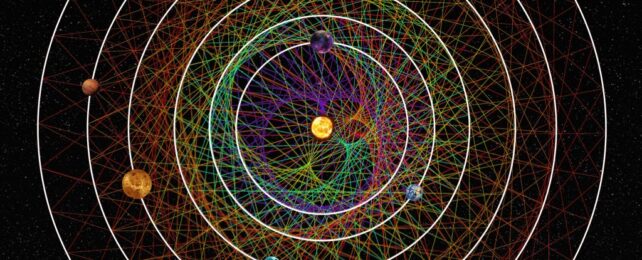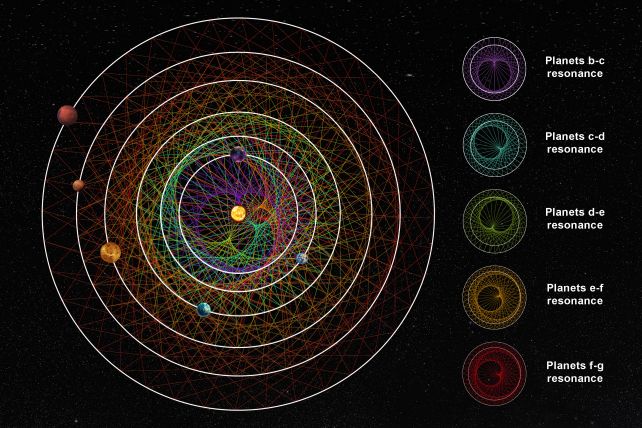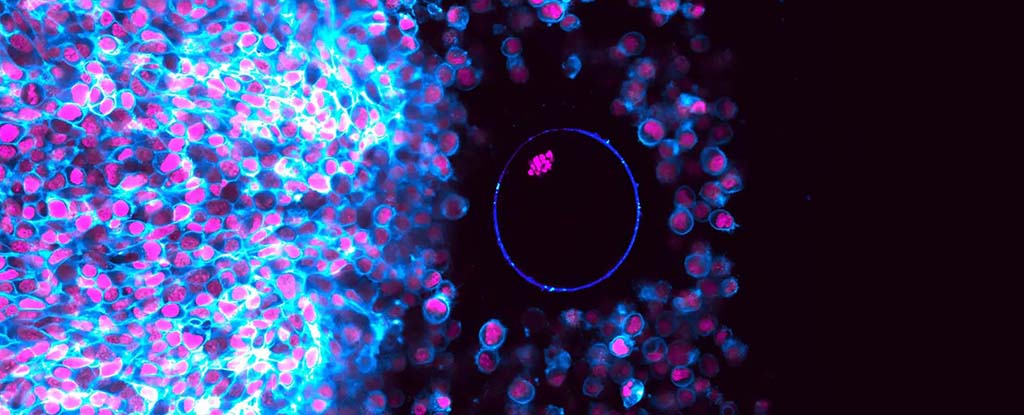ARTICLE AD
 An illustration showing the geometry of the resonance chain of exoplanets around the star HD 110067. (Thibaut Roger, NCCR Planets)
An illustration showing the geometry of the resonance chain of exoplanets around the star HD 110067. (Thibaut Roger, NCCR Planets)
Some 100 light-years from the Solar System dwells the most mathematically perfect planetary system we've ever seen.
The star at its center – a temperate orange dwarf called HD 110067 – is orbited by six exoplanets, each of which travels in harmony with its adjacent worlds. Such a perfect chain of orbital resonances is extremely rare, and it means that the system has remained relatively stable and undisturbed since it formed, around a billion years ago.
This is interesting in its own right, and scientists are studying it accordingly; but it has another implication. Such steady stability, according to a team led by astrophysicist Carmen Choza of the SETI Institute, offers a good opportunity for life to emerge, evolve, grow and thrive.
 An illustration showing the resonance chain of exoplanets around the star HD 110067. (Thibaut Roger, NCCR Planets)
An illustration showing the resonance chain of exoplanets around the star HD 110067. (Thibaut Roger, NCCR Planets)She and her colleagues have conducted a thorough search for radio signals that provide evidence for past or present technology, known as technosignatures. While they turned up precisely zilch, they believe the system is intriguing enough to be worth revisiting in the future with more sensitive observations.
Finding alien technosignatures in the Milky Way is a difficult prospect. The galaxy is very large, and we don't even know what we're looking for. If we take Earth as a template – the only world on which life is known for a certainty (and, by extension, the only world on which technology is known to have emerged) – our radio signals have only propagated for a distance of around 100 light-years What's more, those far off waves would be incredibly faint to boot.
But we can take the type of radio emission produced by Earth technology, and extrapolate from that what some alien technology might look like, to generate a wavelength range and pattern of signals to search for. This is what scientists at SETI have done, and they use this to scan nearby systems to see if they can detect any signals that might match.
The HD 110067 system is a tantalizing one. Not only is it remarkably stable, all six worlds are smaller than Neptune, and some of them could conceivably have liquid water on the surface, which is one of the checkboxes scientists use in the search for life.
frameborder="0″ allow="accelerometer; autoplay; clipboard-write; encrypted-media; gyroscope; picture-in-picture; web-share" allowfullscreen>
To look for alien technology, Choza and her colleagues combed through archival data from the Green Bank Telescope in search for the tell-tale stretching and scrunching of key frequencies as the hypothetical civilization looped back and forth in orbit around its star.
After eliminating any signals that might originate from Earth, the researchers came up with no sign of alien technology from that particular search strategy. Which is kind of a bummer in one sense, but it's only ruling out one possibility of what could be many. When it comes to aliens, we don't even know what we don't know.
What we do know is that all the physical characteristics of HD 110067 remain just as tantalizing as they were before the researchers ruled out technosignatures of a specific nature in the archival Green Bank data.
"While we find no signals with this search, we anticipate returning to this system and others like it in the future with increasingly sensitive and diverse search methods," Choza and her team write in their paper.
"This unusual system remains an interesting target for future technosignature searches."
The research has been published in the Research Notes of the AAS.

 8 months ago
49
8 months ago
49 

